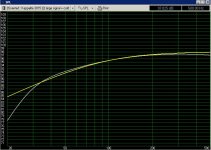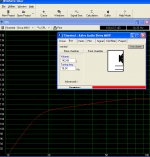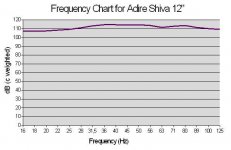infinia said:Vented will never EVER equal to -6B/oct.
Sreten you're wiggling.
See the attached plot:
yellow curve = 6 dB/oct HP at 90 Hz
white curve = Eminence Kappalite 3015 in 4.25 ft^3 tuned to 30 Hz
These curves agree +- 1 dB from 30-500 Hz
By manipulating volume and tuning it's quite easy to achieve a 1st (or 2nd) order rolloff in a ported box over a wide range.
Also, if by "room gain" you mean the behavior below the lowest mode in a room, then the gain (for a sealed room) is 12 dB/oct, not 6 dB/oct. This is because the sound pressure transitions from being a result of the volume accelerated by the speaker to being a result of the volume displaced by a speaker. Holding volume acceleration constant and halving frequency (down 1 oct) corresponds to 4x the volume displacement which corresponds to +12 dB (12 = 20*log(4)).
Attachments
Rybaudio said:Also, if by "room gain" you mean the behavior below the lowest mode in a room, then the gain (for a sealed room) is 12 dB/oct, not 6 dB/oct. This is because the sound pressure transitions from being a result of the volume accelerated by the speaker to being a result of the volume displaced by a speaker. Holding volume acceleration constant and halving frequency (down 1 oct) corresponds to 4x the volume displacement which corresponds to +12 dB (12 = 20*log(4)).
Which is why my sealed bass boxes play flat down to around 20Hz even though they have an f3 of about 50. The cone keeps moving below 20Hz, but my ears lose the sound fairly quickly after that and I can't really distinguish any sound below about 15-16 (and even that only when it's turned up very loud).
If I do get a larger room (Dear?), then I'll build a big vented enclosure for the bottom octave (<piano). I have trouble distinguishing much difference down at that level, and as long as there's air being moved, I'm not that fussed.
And, regarding the 'in-room response', I had assumed that 454Casull was talking about above tuning frequency IRR. It would require some really fancy EQ to get close to really matching an AS and a BR.
Rob - I'm looking around for a PE17 from Rane, which has 5 bands that can all centre at 10Hz and up. But I've only seen 2 in the last 12 months...
Rybaudio said:
See the attached plot:
yellow curve = 6 dB/oct HP at 90 Hz
white curve = Eminence Kappalite 3015 in 4.25 ft^3 tuned to 30 Hz
These curves agree +- 1 dB from 30-500 Hz
By manipulating volume and tuning it's quite easy to achieve a 1st (or 2nd) order rolloff in a ported box over a wide range.
Maybe I should of limited my statement to a reasonable vented alignment for which a woofer was intended. A pro 15" woofer giving f3=85 Hz is unusual at any normal use esp. in a very large box. I know EVER was a too strong word to use.. then all the white paper lab curiosities get rolled out for examination. Note in your example the roll off does go back to 4th order at lower frequencies.
Did you see my reference for room gain. It's also common knowledge that room gain is closest to a first order response 20 hz to 60 Hz. If you say it's not, then I'd like to see your references in that range of frequencies for normal construction methods i.e wall board flex.
infinia said:Maybe I should of limited my statement to a reasonable vented alignment for which a woofer was intended. A pro 15" woofer giving f3=85 Hz is unusual at any normal use esp. in a very large box. I know EVER was a too strong word to use.. then all the white paper lab curiosities get rolled out for examination. Note in your example the roll off does go back to 4th order at lower frequencies.
I wouldn't consider that an unintended or unusual circumstance at all. The idea is to get a little extra output and reduced cone excursion on the lower end of the bandwidth compared to sealed without much of an increase in volume. 4.25 is on the larger side... 3 cubes would be more of a realistic size for such an application. I use an alignment like this in my home system, for example, because (1) I don't want to use 6-8 ft^3 boxes and (2) I have an additional 3 subs covering the bass as well.
infinia said:Did you see my reference for room gain. It's also common knowledge that room gain is closest to a first order response 20 hz to 60 Hz. If you say it's not, then I'd like to see your references in that range of frequencies for normal construction methods i.e wall board flex.
I was talking about below the lowest mode, in a sealed room. If that included 60 Hz we would be in a very small room. This is the only frequency range in which the behavior is simple enough to lablel with a curve like 6 dB/oct. In the modal region, "room gain" is so heavily dependent on the source and listener locations that assigning some slope to it is meaningless.
I don't know where the "common knowledge" comment comes from. I've never heard anyone make that claim. I don't see it made in the link you provided either.
Re: Re: Re: Reflex vs sealed
I don't know what kind of walls the RRC software uses to calculate room gain... Maybe perfect theorical walls. Maybe that's why you can see the theorical 6 dB per octave of gain. Everybody has a different answer.
I tend to believe in Dan Wiggins who measured a "standard sized" room per IEC with "standard drywall". His measurements showed between 2 dB per octave to 3 dB of gain per octave starting at 160 Hz IIRC.
That's why I designed a tweaked EBS subwoofer to match that 2-3 dB per octave curve from 80 Hz (subwoofer is crossed at 80 Hz with a 4th order Linkwitz Riley) to 18 Hz, with a 18 Hz tuning in a large box. It measured flat in room.
So according to my personal experiences, 6 dB per octave, not in your wildest dreams. A sealed subwoofer cannot match room gain, the rolloff is too fast.
I fully agree with sreten in that vented, if built and tuned well, will integrate with room gain much better than sealed.
infinia said:It's the other way round. Sealed integrates better with in room gain than Vented. Although they both don't fit in perfectly.
Sealed generally is much easier on the ear with equal F-3dB (less boomy resultant). Room Gain is +6 dB/octave. see http://www.pvconsultants.com/audio/reflection/rrc.htm
I don't know what kind of walls the RRC software uses to calculate room gain... Maybe perfect theorical walls. Maybe that's why you can see the theorical 6 dB per octave of gain. Everybody has a different answer.
I tend to believe in Dan Wiggins who measured a "standard sized" room per IEC with "standard drywall". His measurements showed between 2 dB per octave to 3 dB of gain per octave starting at 160 Hz IIRC.
That's why I designed a tweaked EBS subwoofer to match that 2-3 dB per octave curve from 80 Hz (subwoofer is crossed at 80 Hz with a 4th order Linkwitz Riley) to 18 Hz, with a 18 Hz tuning in a large box. It measured flat in room.
So according to my personal experiences, 6 dB per octave, not in your wildest dreams. A sealed subwoofer cannot match room gain, the rolloff is too fast.
I fully agree with sreten in that vented, if built and tuned well, will integrate with room gain much better than sealed.
infinia said:
Sreten you're wiggling.
edit>Hmmm... you deleted your post after mine above.
Hi,
Yes indeed ....... I was on my soapbox regarding loudspeakers.
For subwoofers optimum positioning to utilise room gain (the
9dB or so related to boundaries) is not very practical / friendly.
Room gain related to pressure I do not know much about, I
know there is theoretical gain, but that needs a sealed room.
I deleted my post because I was not sure it is applicable to subs.
It also depends on your ears. If you have sensitive hearing and sensitive balance (inner ear), you'll like the sealed better for normal mortal listening. How high you are crossed over makes a big difference.
To my ears a two way sealed sounds more accurate than a ported and is easier to listen to. The phasing caused by the port and escaping box resonance in most consumer cabinets drives me nuts and is very fatiguing. I like a two way sealed with a ported sub crossed over 80 or below just to add thump.
I also like sealed midrange horn cabinets over all ported direct radiators except UP-1a.
At lower volumes the ported probably "Sounds Better" because of the bass boost from the port.
If I had to build a "Home box" with only a woofer and tweeter, I'd
probably build a ported but with a really long port out the back of the box, or a tuned cavity to pull up the low end just past where the woofer starts rolling off and not before.
I'd probably try to mount the tweeter centered over the woofer
as well with a cone or dome behind the magnet of the tweeter like a phase plug.
Just my 2cents.
To my ears a two way sealed sounds more accurate than a ported and is easier to listen to. The phasing caused by the port and escaping box resonance in most consumer cabinets drives me nuts and is very fatiguing. I like a two way sealed with a ported sub crossed over 80 or below just to add thump.
I also like sealed midrange horn cabinets over all ported direct radiators except UP-1a.
At lower volumes the ported probably "Sounds Better" because of the bass boost from the port.
If I had to build a "Home box" with only a woofer and tweeter, I'd
probably build a ported but with a really long port out the back of the box, or a tuned cavity to pull up the low end just past where the woofer starts rolling off and not before.
I'd probably try to mount the tweeter centered over the woofer
as well with a cone or dome behind the magnet of the tweeter like a phase plug.
Just my 2cents.
Several books on Acoustics and Physics detail boundary loading and room gain such as this one:
Acoustics and psychoacoustics By David M. Howard, Jamie Angus
page 31 ( Google book preview available )
I don't have a strong preference of Sealed vs Ported ( I've built many of both ).
The biggest advantage ( to a DIYer ) of going sealed is the outcome is more predicable vs a tuned cab which introduces the added complexity of selecting and tuning a port. A sealed cab is much more forgiving of the loose T/S tolerances found in speakers.
For best results tuned cabs require the ability to run an impedance sweep.
Acoustics and psychoacoustics By David M. Howard, Jamie Angus
page 31 ( Google book preview available )
I don't have a strong preference of Sealed vs Ported ( I've built many of both ).
The biggest advantage ( to a DIYer ) of going sealed is the outcome is more predicable vs a tuned cab which introduces the added complexity of selecting and tuning a port. A sealed cab is much more forgiving of the loose T/S tolerances found in speakers.
For best results tuned cabs require the ability to run an impedance sweep.
Simon5 wrote:
"[M]easurements showed between 2 dB per octave to 3 dB of gain per octave starting at 160 Hz IIRC.
"That's why I designed a tweaked EBS subwoofer to match that 2-3 dB per octave curve from 80 Hz (subwoofer is crossed at 80 Hz with a 4th order Linkwitz Riley) to 18 Hz, with a 18 Hz tuning in a large box. It measured flat in room.
"So according to my personal experiences, 6 dB per octave, not in your wildest dreams. A sealed subwoofer cannot match room gain, the rolloff is too fast."
I fully agree with simon5's analysis and approach. That's what I do in my commercial subwoofer system.
Duke
"[M]easurements showed between 2 dB per octave to 3 dB of gain per octave starting at 160 Hz IIRC.
"That's why I designed a tweaked EBS subwoofer to match that 2-3 dB per octave curve from 80 Hz (subwoofer is crossed at 80 Hz with a 4th order Linkwitz Riley) to 18 Hz, with a 18 Hz tuning in a large box. It measured flat in room.
"So according to my personal experiences, 6 dB per octave, not in your wildest dreams. A sealed subwoofer cannot match room gain, the rolloff is too fast."
I fully agree with simon5's analysis and approach. That's what I do in my commercial subwoofer system.
Duke
audiokinesis said:Simon5 wrote:
"[M]easurements showed between 2 dB per octave to 3 dB of gain per octave starting at 160 Hz IIRC.
"That's why I designed a tweaked EBS subwoofer to match that 2-3 dB per octave curve from 80 Hz (subwoofer is crossed at 80 Hz with a 4th order Linkwitz Riley) to 18 Hz, with a 18 Hz tuning in a large box. It measured flat in room.
"So according to my personal experiences, 6 dB per octave, not in your wildest dreams. A sealed subwoofer cannot match room gain, the rolloff is too fast."
I fully agree with simon5's analysis and approach. That's what I do in my commercial subwoofer system.
Duke
So lets see, you also do an EBS tweaked to 2-3dB/oct from 18-80Hz, I'd really like to see a reasonable, working, and practical example of that. WinISD Plots?
Infinia, I don't do exactly the same thing that simon5 does - I just use the same approach.
It's not quite an EBS tuning, as the target response is a curve that slopes gently downward at about 3 dB per octave, then of course rolls off rapidly below the tuning frequency. Perhaps this approach deserves its own acronym. I propose "RGC", for "Room Gain Complimentary" tuning.
It's not really all that difficult, but like anything else you have to do some modelling to find woofers that will do what you want in a box size you can live with.
Duke
It's not quite an EBS tuning, as the target response is a curve that slopes gently downward at about 3 dB per octave, then of course rolls off rapidly below the tuning frequency. Perhaps this approach deserves its own acronym. I propose "RGC", for "Room Gain Complimentary" tuning.
It's not really all that difficult, but like anything else you have to do some modelling to find woofers that will do what you want in a box size you can live with.
Duke
Simon5, thanks for posting an example. I didn't have time to yesterday.
Regarding your posted in-room measurement, I would have expected to see a peak-and-dip pattern at the microphone position due to room interaction. Is that a spliced close-miked measurement, or an average of several microphone locations? Or, were you using warble-tones?
Thanks,
Duke
Regarding your posted in-room measurement, I would have expected to see a peak-and-dip pattern at the microphone position due to room interaction. Is that a spliced close-miked measurement, or an average of several microphone locations? Or, were you using warble-tones?
Thanks,
Duke
audiokinesis said:Regarding your posted in-room measurement, I would have expected to see a peak-and-dip pattern at the microphone position due to room interaction.
It's not what you would call a professional FR curve hehe ! It was measured with a computer frequency generator, using a Creative Audigy 4, single sinusoidal frequency at a time. Input 16 Hz, take a measurement, repeat at interval of 4 Hz or so, up to 125 Hz. So it was about 20 discrete measurements...
That's why I stated several times that it's not perfect, but it gives an idea.
You could post a better design with a better FR curve, I'm sure !
- Status
- This old topic is closed. If you want to reopen this topic, contact a moderator using the "Report Post" button.
- Home
- Loudspeakers
- Subwoofers
- Reflex vs sealed


